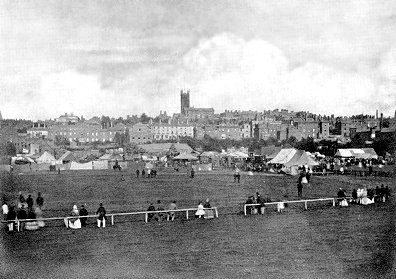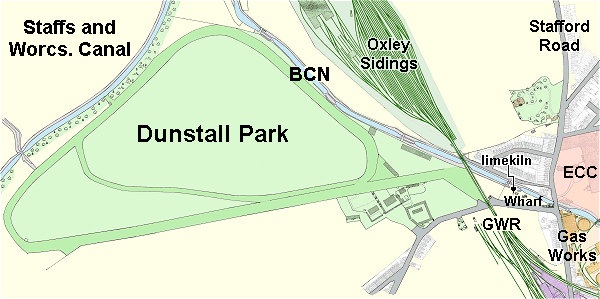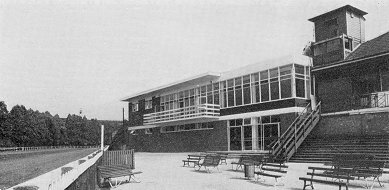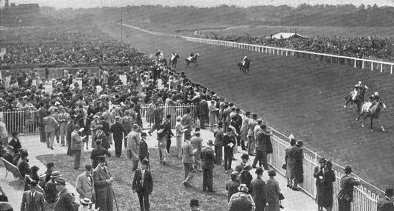|

An early race meeting. |
The Old Course For the first 50 years of its life, Wolverhampton Race Course was
situated at Broad Meadows, an area of marshland just north of
Tettenhall Road, and to the west of Wellington Road, now known as
Waterloo Road.
The old course had many facilities including a
handsome grandstand, built in 1827 and a row of stands and booths
which stretched for a quarter of a mile.
There were side shows,
shooting galleries, and even a cock-pit for cock fighting. |
| Race meetings were held at Broad Meadows until the lease ended in
1878, when West Park was built on the site.
It took several years to
find a suitable location for a new race course.
An unforeseen set of
circumstances however, soon led to the acquisition of an ideal piece
of land. |

The Grandstand. |
| Sir Alexander Staveley Hill lived at Dunstall Hall, after being
born there in 1825. He vigorously opposed the building of the
Shrewsbury & Birmingham Railway which approached Wolverhampton just
beyond the northern edge of his estate. He also greatly objected to
the building of railway workshops, offices, and locomotive sheds on Dunstall Hill. The railway opened in November 1849 and became part
of the Great Western Railway in September 1854. He must also have
been extremely annoyed when the railway company extended the
facilities on Dunstall Hill to include a locomotive works. His father, Henry Hill, inherited Oxley Manor in 1870. When Henry
died in 1872, Alexander Staveley Hill decided to move to Oxley, and
put the Dunstall Estate on the market. Dunstall Park was an ideal
location for a new racecourse. It covered 130 acres of flat land in
an excellent locality, on the northern side of the town, with good
access.
Two prominent horse racing enthusiasts, Robert Hermon Hodge, M.P.
for Accrington, and Mr. John Lees, J.P. decided to set up a public
company to purchase Dunstall Park and build a new racecourse there.
The new company, Wolverhampton Racecourse and Dunstall Park Limited
held its first meeting on 16th June, 1887 in London. Within a few
weeks the estate had been purchased for £36,000. The money raised
was as follows: £15,000 came from the sale of 3,000 shares at £5
each, a further £15,000 from a debenture, and £6,000 cash. When the
transaction had been completed, Alexander Staveley Hill joined the
board and became the company’s first permanent chairman in October
1887.
|
|

Dunstall Hall by John Fullwood. |
The site would prove to be just right for the new course. Even
before the land had been acquired, a small two-day race meeting had
taken place in October 1886 under National Hunt Rules.
The
facilities at the time were extremely poor, the main attraction
being the Wolverhampton Hurdle with prize money of only £70.
Even so
a number of famous riders took part, and the scene was set for future
events. |
| The Early Years By early 1888 arrangements were put in place for the building of
the course. Henry Willcock, a Wolverhampton builder secured the
contract to build the stands, and John Sheldon of Birmingham became
the first Clerk of the Course. The first meeting had been arranged
for 23rd April, but this had to be cancelled because a lot of
building work still had to be done.
The first meeting actually took place on 13th August, the first
event being the five furlong All-Aged Maiden Plate, which was won by
Tommy Loates riding “Silver Spur”. Other races included the
Albrighton Welter Plate and the Bushbury Selling Plate. Right from
the start many well known figures in the racing world came to the
race meetings, which were a great success.
One famous personality, who came in 1894 was Lillie Langtry the
famous actress who had a great interest in horse racing and owned a
number of horses. Although she is well remembered as the mistress of
the Prince of Wales, she also had other affairs. One of her many
lovers was Scottish iron-mining millionaire George Alexander Baird,
a staunch supporter of Dunstall Park, who rode his own horses under
the name of “Squire Abingdon”.
|

The location of the racecourse.
On the
western side of Stafford Road canal bridge (Gorsebrook
Bridge) was a wharf. Originally it contained
a limekiln, and a smithy, presumably
catering for the horses that pulled the
canal boats. From the early 1940s, through
to the 1960s, the Stafford Timber Company
was located there. |
The affair ended after a fit of jealousy when he lost control of
his temper and beat her so badly that she ended up in hospital for
10 days, with many injuries including two black eyes. He beat her on
several occasions and would apologise afterwards, giving her large
sums of money or expensive gifts. On this occasion he gave her a
200ft. luxury yacht called the “White Lady”. As a result she dropped
all charges against him and the yacht became known as the “Black
Eye”.
On an earlier occasion he gave her a fine chestnut colt from his
stable, called “Milford”, who won his maiden race at Kempton Park.
Lillie raced her horses under the name of “Mr. Jersey” and during
her 1894 visit to Wolverhampton she won the Dudley Plate with her
horse, “Montpensier”.
In 1895 Dunstall Park became the only course in Staffordshire to
stage flat racing due to the closure of the Lichfield course. The
following year the racecourse company persuaded the Great Western
Railway to build a station at Dunstall and contributed £500 towards
the cost of the building, which came to just under £5,000.
1910 got off to a bad start. The first race meeting was cancelled
as a mark of respect to King Edward VII who died in May. This was
followed by the dismissal of the racecourse company’s secretary,
Edward Cresswell for embezzlement. He had been company secretary for
23 years
|
| Aviation In June 1910 the first all-British flying meeting took place at
Dunstall Park, only 4 years after the first ever flight in Europe.
The newspapers reported that by the beginning of the month 6 hangars
had been erected and Bleriot, Humber and Star machines were already
there. A Mr. Hartill of Cleveland Street, Wolverhampton constructed
a machine especially for the event.
Unfortunately there was almost
no flying because of high winds, heavy rain, and a dispute with some
pilots over payment of their hotel expenses.
The meeting began on 27th June and lasted for 5 days, ending on
2nd July. It was held under the auspices of the Midland Aero Club,
which had been formed the previous year. Its headquarters were at
the Grand Hotel in Birmingham and the club president was the Earl of
Dartmouth. The official programme listed a varied selection of
events. Prizes were awarded for the flight of the longest duration,
cross-country flying, passenger carrying, figure flying, bomb
throwing etc.
|
 |
|

A postcard especially produced for
the event. |
The first flight was made by Captain Dawes, on leave from the
army to learn how to fly. He decided to fly around the trees at the
end of the park, but could not turn in time and sailed over the
fence to end up in a field beyond.
Thanks to the atrocious
conditions there were a number of spectacular crashes. James Radley’s Bleriot crashed in a gale and Alec Ogilvie’s Short-Wright
aircraft fell to the ground from a height of 60ft. Radley and Gibbs
also crashed, but luckily survived without injury. |
| Prizes were distributed on the last day. Graham White made the
first circuit flight and won the duration prize by keeping his
aircraft in the air for 15 minutes and 38 seconds. Mr. Boyle won the
monoplane class by flying for nearly 8 minutes. Mr. Grace won the
prize for the highest flight, reaching nearly 600 feet. Mr. G. B.
Cockburn won the prize for the shortest take-off in his Farman
biplane over a distance of 100ft. 5 inches. The most successful local man was Mr. Barnes who kept his machine
in the air for 77 seconds. A Wright biplane won the speed contest,
piloted by Mr. C. S. Rolls, one of the founders of Rolls Royce.
Unfortunately he was killed less than two weeks later during a
similar contest at Bournemouth, which highlighted the danger involved
in such events. Granville Bradshaw piloted the locally built Star
monoplane, which unfortunately failed to fly.
Other pilots included Mr. Davies, A.V. Roe, Mr. Gilmour, Mr.
Mander, Mr. Lane, Mr. Cody, Mr. Holder, Mr. Frances, Mr. McArdle,
and Mr. Maxfield. Music was provided by the South Staffordshire
Regiment and the Wolverhampton Military Band. The event proved to be
very popular and aviation meetings were held at Dunstall Park for
several years.
|
| The locally built Star monoplane returned in 1911 with Joe Lisle,
son of the company’s owner, Edward Lisle, at the controls.
This time
the aircraft successfully flew and Edward was so alarmed at the
sight, that he banned his son from flying again. |

The Star monoplane. |
| A Brief Return to Racing In 1912 the company’s chairman, John Lees died at the age of 89
after suffering a stroke. He was succeeded by Henry Staveley Hill,
M.P., son of the first chairman. The facilities at the course
were improved in 1913 with work on the stands and the construction
of the club premises. The Shifnal Selling Handicap was held in
October and this resulted in a dead heat between Steve Donoghue
riding “Kinglet” and Sidney Seymour riding “Tramp IV”. On such an
occasion it was customary for the owners to divide the stakes, if
the owners did not agree to do so, a deciding heat had to be run.
On this occasion a deciding heat was run and “Kinglet” ended in
first place by three quarters of a length.
The summer meeting in 1914 was cancelled due to the outbreak of
war. Although the racecourse company offered the buildings and
grounds to the government to help with the war effort, the offer was
declined. In 1916 Courtaulds purchased a strip of land on the edge
of the course, for the building of their new factory. As a result
races were then restricted to 5 furlongs and 190 yards.
Between the Wars
Racing resumed in May 1918, six months before the end of the war.
The event included the Madeley Handicap, The Bradford Two-Year-Old
Plate, and the Dunstall Juvenile Selling Plate. All three races were
won by Steve Donoghue in the colours of Mr. Frank Curzon.
Jumping resumed at the course in January 1919 and many famous
horses took part in such races as the Walsall Handicap Steeplechase,
the Oteley Handicap Steeplechase, the Wyfold Hurdle, and the
Staffordshire Steeplechase.
|
|

The grandstand. |
In September 1919 there were only two runners in the
Autumn Handicap; Lady Torrington’s
“Rich Gift” ridden by Freddie Fox, and Brigadier Charles
Lambton’s “Pallene”, ridden by George Hulme.
The
race resulted in a dead-heat and the owners decided to share the
stakes. |
| A famous visitor to the course, Sir Gordon Richards, paid his
first visit on 18th June, 1922 when he came second in the
Apprentices’ Stakes, riding “Knight of the Orient”. A tragedy took place at the Christmas meeting in 1924 when
Captain “Tuppy” Bennet took a fall in the Oteley Handicap
Steeplechase while riding “Ardeen”. He was kicked in the head and
died without regaining consciousness. As a result the wearing of
crash helmets became compulsory in steeplechase and hurdle events.
Sir Gordon Richards came to the August meeting in 1935 and became
the star of the event. He won the Bushbury Plate, the Himley Selling
Plate, the Shrewsbury Selling Plate, and the Walsall Handicap. Quite
an achievement.
There were many other memorable events and successful meetings in
the 1930s, but it all came to an end in September 1939 at the
outbreak of war, when all meetings were cancelled.
After the War
During the war the ground had been neglected, and more seriously
the company had no reserves of capital. Luckily they wisely invested
what little they had and within 5 years they accrued an impressive
£150,000.
The race meetings continued to be a great success. In July 1950
another famous visitor Lord Astor had a successful meeting. His
chestnut gelding “High Stakes” won the Shrewsbury Stakes. The next
day Lady Baron’s horse “Tangle” ridden by Tommy Hawcroft won the
Deepfields Plate with odds of 50 to 1.
Further improvements were made at the course in the mid to late
1950s. In 1955 and 1956 the stands were covered, and in 1957 the
Champagne and Oyster Bar was built. In 1958 the Paddock Buffet Bar
opened, and in 1959 three round courses for flat racing, hurdling,
and steeple chasing were constructed at a cost of £3,400. The
improvements continued the following year with the installation of a
modern watering system, and better amenities in the bar under the
Silver Ring stand.
|
| On 14th September, 1964 the Queen had her first success at the
course when her horse “Menai”, ridden by Geoff Lewis won the
Bushbury Maiden Plate.
In October 1966 Wolverhampton staged the
National Hunt Hurdle Cup as part of the celebrations of the first
100 years of the National Hunt Committee. The race was won by Mr. K.
F. Alder’s horse “Saucy Kit”, ridden by Roy Edwards. |

The grandstand in the late 1960s. |
|

A meeting in the late 1960s. |
The new Club Building opened in 1968 with a weighing
room, jockeys changing room, and a banqueting suite.
In 1970 the young Pat Eddery won the Dunstall Derby,
which was to be the first of many such wins during his
outstanding career.
|
| Recent Times During the 1970s and 1980s the course went from strength to
strength, with the racecourse company achieving record profits in
1986. By the late 1980s Dunstall Park’s future was threatened by
plans to turn it into a shopping centre. The new owners RAM
racecourses resisted the proposal and took advantage of City
Challenge funding to greatly improve the facilities at the course.
The £15.7 million scheme included the addition of floodlighting, the
laying of a Fibresand all-weather surface, and the building of a
hotel and exhibition hall. The all-weather circuit is almost
completely flat, oval-shaped and about a mile in length. The first
event after the completion of the work took place on 27th December,
1993, when 10,000 people attended the meeting. In 1999 the racecourse
and hotel were purchased by Arena Leisure Plc.
In 2001, the track was further improved with the laying of 7,600
tons of Fibresand over 140 new lateral drains, and in 2004, the
Fibresand and turf track were replaced with a Polytrack surface.
Since that time, only flat, all-weather racing has taken place
there.
Unhappily during 2006 doubts were cast about the safety of the
polytrack surface due to 6 incidents which took place over a period
of 5 weeks, resulting in 5 horse fatalities and several injuries to
riders. The course was inspected by an inspector from the
Horseracing Regulatory Authority, and was given a clean bill of
health.
Dunstall Park is now the last surviving racecourse in the West
Midlands, and is Britain's first floodlit racecourse. It is extremely
busy, hosting around 100 meetings a year, including its themed
Saturday evening events. There are bars, restaurants, and a busy
Conference and Exhibition centre, even having a licence to perform
civil weddings. The course also has it own hotel, the 'Holiday Inn
Garden Court' with 54 rooms, a restaurant, fitness room and
conference suites. It is very successful, and hopefully will
continue to thrive in the future.
|
 |
Return to the Canals
and Industry Menu |
|